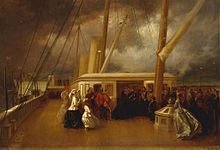In just a couple of days, Jon was able to gather enough material about Starcross's past to fill 6 large tables and a notice board. He had decided to focus on Victorian Starcross, and had asked the question 'Did Queen Victoria ever come to Starcross.' The internet provided the answer; on a page from one of her diaries. It described a journey from Budly Salterton to Powderham, in her yacht HMY Victoria and Albert -
but Jon hadn't included the next page of the diary. Could that have mentioned something of Starcross? 'What did Starcross look like as Queen Victoria sailed past? What would Queen Victoria have thought?'
To find the answers, the history group examined the quantities of photographs, maps and documents, and then reflected on the picture painted of life in Victorian Starcross. Census material from the internet contained familiar surnames, particularly, Anning. Occupations included railway porter, railway policeman, housekeeper, and blacksmith. There was talk of the Starcross Quay, which was called Ashes Quay; and more conversation about Ashes Field. What did we know about the Ash family of Starcross?
Photographs of Starcross today also asked questions. Why was Brickyard Lane so named? Another photograph was of a local resident who had told Jon all sorts of lovely stories about Starcross, which he had written down for us to read. Some of us already knew those stories, but some of us hadn't heard them before. This made us realise that we must make records of our oral histories.
Jon emphasised that today's biggest resource is the internet. There's information available to everyone, on any topic.
There was enough material on those 6 tables, to enable us to write a book about Victorian Starcross... but perhaps we would like to write about another aspect of Starcross's history?
BTW here's the next page - no thoughts from Victoria about Starcross, and Powderham Castle - (Lord Devon's place) was only seen from a distance. Aaahhh. shame...
but our imaginations worked hard as we thought about what Victoria's impressions of our village might have been; as she sailed so close on 30th August, 1843
From Wikipedia, the free encyclopedia
For other ships with the same name, see List of ships named HMY Victoria and Albert.
| This article does not cite any sources. (December 2009) (Learn how and when to remove this template message) |

HMY Victoria and Albert, depicted during a royal visit to Le Tréport, France; September 1843.
|
|
| History | |
|---|---|
| Namesake: | Queen Victoria and Albert, Prince Consort |
| Builder: | Pembroke Dock |
| Laid down: | 1842 |
| Launched: | 25 April 1843 |
| Renamed: | Osborne, 1855 |
| Fate: | Scrapped, 1868 |
| General characteristics | |
| Type: | Royal Yacht |
| Tons burthen: | 1034 |
| Installed power: | 430 hp (320 kW) steam engine |
| Propulsion: | Twin paddles |
| Armament: | 2 guns |
Queen Victoria and Abdülaziz of the Ottoman Empire on the Royal yacht during the Sultan's official visit to United Kingdom.
The ship's figurehead is preserved above the door of the South Office Block in Portsmouth's Royal Dockyard.[1]
References
- Queen Victoria's Journals. Journal entry: Wednesday 30th August 1843. http://www.queenvictoriasjournals.org/search/displayItem.do?FormatType=fulltextimgsrc&QueryType=articles&ResultsID=2947854968511&filterSequence=0&PageNumber=1&ItemNumber=1&ItemID=qvj03986&volumeType=PSBEA Accessed online 15/09/2016
- HMY Albert and Victoria - https://en.wikipedia.org/wiki/HMY_Victoria_and_Albert accessed online 15/09/2016
- 1841, 1851, 1861, 1871, 1881 Census. Crown Copyright. The National Archives, London England available online http://www.ukcensusonline.com/index.php accessed 15/09/2016




No comments:
Post a Comment
Hooray! You're posting a comment. Many thanks.